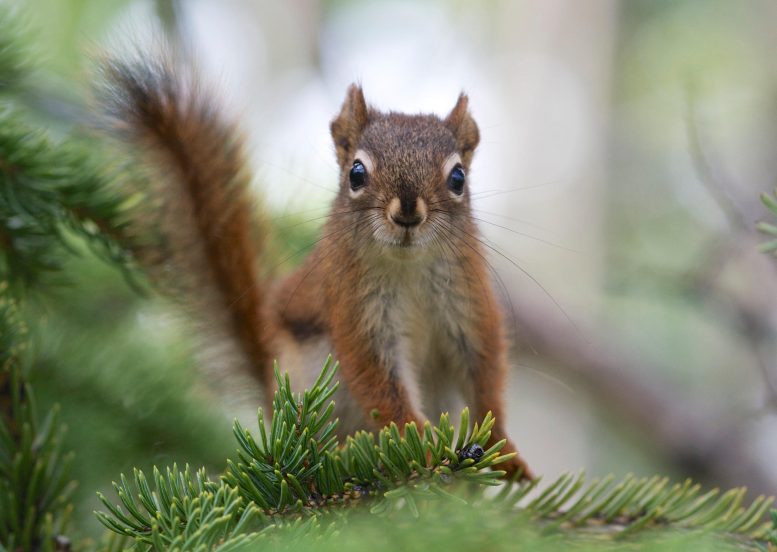
Juvenile North American red squirrel in the Yukon, Canada. Credit: Ryan Taylor
Imagine overhearing the Powerball lottery winning numbers, but not being aware of when they will be announced – only that it will occur sometime within the next decade or so. Despite the daily financial expenses of playing those numbers during that span, the reward is substantial enough to make it a worthwhile investment.
Animals inhabiting environments with highly variable environments play a similar lottery with regard to their Darwinian fitness, which is a measure of their ability to transmit their genes. In a recent study led by the University of Michigan, researchers discovered that red squirrels that took chances with reproduction outperformed those who didn’t, even if it cost them in the short term.
Natural selection favors female squirrels that have large litters in years when food is abundant because they contribute lots of babies to the gene pool, said Lauren Petrullo, lead author and National Science Foundation postdoctoral research fellow in biopsychology at the University of Michigan.
“We were surprised to find that some females have large litters in years when there won’t be enough food for their babies to survive the winter,” she said. “Because it’s biologically expensive to produce offspring, we wanted to know why these females make what appears to be an error in their reproductive strategy.”
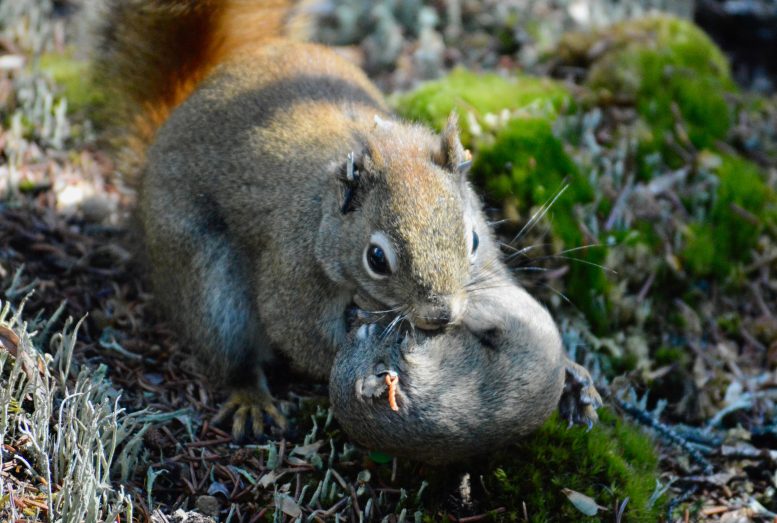
Female North American red squirrel moving one of her pups from one nest to another in the Yukon, Canada. Credit: Erin Siracusa
The red squirrels studied live in the Canadian Yukon and experience a “mast year,” or boom in their main food source—seeds from the cones of white spruce trees—once every four to seven years. Squirrels forecast the large mast crop of food before it occurs and increase litter sizes in the months prior, ensuring better future survival for their babies and better fitness for themselves.
“There is a constant tug-of-war between the trees and the squirrels at our study site,” Petrullo said, “with each player trying to deceive the other for its own fitness gain.”
Petrullo and Ben Dantzer, U-M associate professor of psychology and of ecology and evolutionary biology, used data collected by the Kluane Red Squirrel Project, a collaborative, 34-year-old field study involving U-M, the University of Colorado, the University of Alberta, and the University of Saskatchewan.
“Each year, we collect data on how many babies squirrels produce and how many spruce cones the squirrels eat,” Dantzer said.
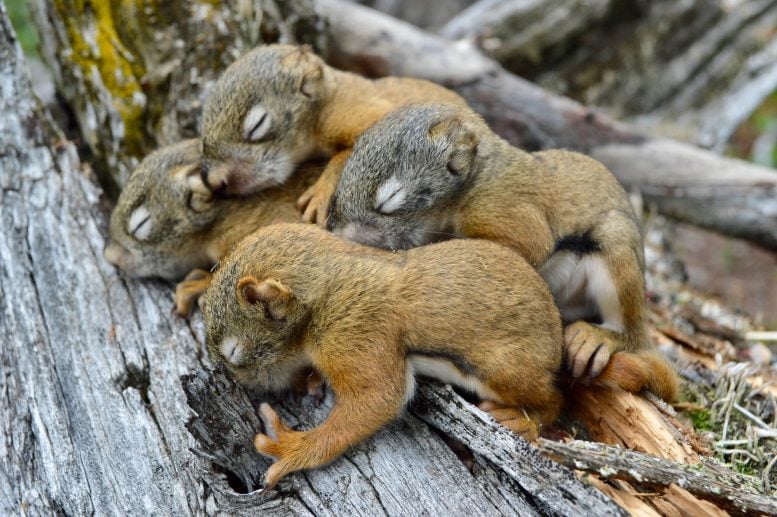
North American red squirrel pups in the Yukon, Canada. They are about 25 days old. Credit: Erin Siracusa
The scientists quantified the reproduction of female squirrels during both food booms and busts, discovering differences in their fitness whether they gambled with their reproductive strategy or not. While some squirrels played it safe by keeping litter sizes small each year, those that took a “pie in the sky” approach by having large litters even when food was scarce enjoyed greater lifetime fitness if they got to experience a mast year, the research showed.
Unlike the Powerball example, though, squirrels aren’t guaranteed to eventually win.
“In some ways, this strategy of gambling with litter sizes is like playing with fire,” Petrullo said. “Because the average squirrel lifespan is 3.5 years and masts only happen every four to seven, a female could potentially be sabotaging her fitness by having too many babies in low-food years, hoping for a mast when she may die before she ever gets to experience a mast at all. This could be pretty costly.”
Alternatively, for squirrels, the cost of not gambling at all in the game of reproduction can be insurmountable if they end up missing their shot at the jackpot.
“It’s essentially impossible for a female to recuperate the fitness costs of not ramping up reproduction in a mast year, so the stakes are extremely high,” Petrullo said.
Females that increased litter sizes in low-food years did take a short-term hit to their fitness. But they were more likely to increase litter sizes if and when they experienced a mast, taking home the ultimate prize of greater lifetime reproductive success, she said.
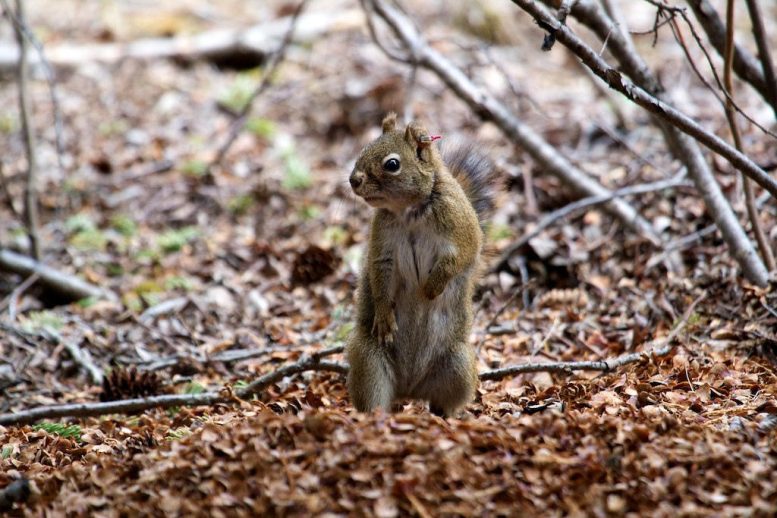
Female North American red squirrel in the Yukon, Canada with a radio-collar on, standing on its midden (bracts and debris from spruce cones). Credit: Juliana Balluffi-Fry
The squirrels’ best bet, according to the researchers, is to take their chances and suffer short-term fitness costs in order to avoid the unmatched cost of missing the fitness jackpot completely.
“Determining the relative costs of different types of errors is key to understanding why animals make what look to us like mistakes,” Petrullo said.
Scientists are still unsure exactly how the squirrels are able to forecast future food production. The animals may be eating parts of the spruce trees that affect their physiology and alter the number of babies they produce, Dantzer said.
“This is exciting because it suggests that squirrels are eavesdropping on the trees, but we still have much more to do to solve this puzzle,” he said.
Because many animals use cues about things like food in their environment to make reproductive decisions, and the reliability of these cues is declining due to global climate change, scientists also wonder how the costs of these types of errors will alter what is the best reproductive strategy.
“If the predictability of a food boom is reduced and squirrels can no longer forecast the future, this could impact the number of squirrels out there in the Boreal forest,” Dantzer said. “This could be problematic given that squirrels are prey for many predators.”
Reference: “Phenotype–environment mismatch errors enhance lifetime fitness in wild red squirrels” by Lauren Petrullo, Stan Boutin, Jeffrey E. Lane, Andrew G. McAdam and Ben Dantzer, 19 January 2023, Science.
DOI: 10.1126/science.abn0665
The study was funded by the National Science Foundation and the Natural Sciences and Engineering Research Council of Canada.

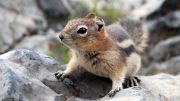
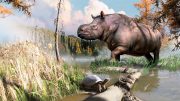

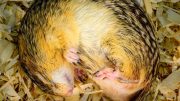
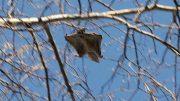



Be the first to comment on "Playing the Reproduction Lottery: How Squirrels Gamble for a Better Future"